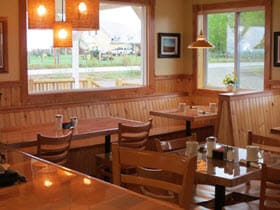When making a restaurant design plan, it’s important to consider what kind of ambiance you want to create for your customers. By giving your customers a complete experience that engages all of the senses, this will increase traffic to your restaurant in several ways. Satisfied customers who have enjoyed delicious food complemented by visual, acoustic, aromatic and haptic stimuli will likely return as repeat customers. These same satisfied customers will also increase your business by word of mouth. Foot traffic from the street will also increase when potential customers are exposed to an inviting exterior, large windows showing a visually pleasing interior, an enticing aroma of your baked goods wafting through the air and alluring acoustics will all draw people in.
Design your restaurant with these tips to get more visitors

Lighting:

People experience 5 senses: sight, smell, touch, taste and hearing. It’s important to engage all of the senses when targeting your customers in order to give them an enjoyable sensory experience. The sense of sight usually receives the most attention in restaurant design. This is the sense that is easiest to engage in restaurant interior design, whether your restaurant is themed or is trying to achieve a specific design décor such as casual or elegant. A themed restaurant may be based on a place like the Caribbean, the Amazon jungle or Tuscany. The theme can also be related to a specific era such as the 1950’s or medieval times or the theme can be less focused such as modern industrial or a traditional cottage design. The interior designer should pay close attention to visual aspects such as color, lighting, seating arrangement, materials and décor. A well designed interior plan will engage customers visually, psychologically and physically and complement the other senses.
An important visual aspect of interior design that is often overlooked is the use of light. The use of large windows, skylights and other natural lighting will help give a café or eatery a light, airy feel that will put customers at ease, increase their appetite and generate a positive mood. Other types of restaurants, such as fine dining restaurants, bars or supper clubs may be looking to create a more intimate ambiance. This can achieved by using soft lighting, candlelight, dim lights to give the venue a more romantic feel.
Taste and Smell:

The senses of taste and smell go hand in hand and are two sense that are often overlooked in the interior design process. Taste is complementary to smell as both senses are used when eating and customers will come back for good-tasting food. Smell affects the area of the brain that deals with motivation, emotions and other feelings. People often associate the sense of smell with strong emotional memories, such as the smell of cookies baking in a kitchen. Odor lends character to a location and can define it. The strong odor of coffee and pastries usually identifies coffee houses such as Starbucks, just like the smell of smoky BBQ is associated with a BBQ rib joint or a steakhouse. One way to tap into the olfactory senses is to allow your signature odor to waft into the dining area, or out onto the street using exhaust fans. Other odors such as fragrances can also be used to set a more enjoyable mood.
Sound:

Sound also has a strong effect on human emotions. Often times a familiar song can evoke strong memories and the style, pace and type of music can set a particular mood. Different establishments can use various types of music to set the desired mood and tone. An elegant, upscale restaurant may want to set a formal mood with classic music or café may be looking to set a relaxing, casual mood with soft jazz. For certain themed restaurants such as 1950’s diner, classic rock n’ roll will be played either through a sound system or an authentic jukebox. Music can also be played on outdoor speakers to draw customers in.
The interior acoustics are also important in setting a relaxing ambiance as sound plays an important role in perceiving a space and enhancing sensory perceptions. Sound complements visual stimuli by providing a spatial context. Usually with very busy, crowded restaurants the aim is to bring down the noise level to give customers a more relaxing experience. A loud environment can be disconcerting an annoying to diners as the noise level can make it difficult to have a conversation. Noise absorbing tiles in the ceiling can help lower the decibel level and certain types of flooring such as wood are better at absorbing sound such as concrete or tile which tends to bounce sounds around more.
Touch:

Lastly, the sense of touch is also an important aspect of restaurant design that is often over looked, This can be best utilized by incorporating building materials with texture, especially in areas where customers can reach and touch it in the interior and exterior. Examples would be a brick or stone wall for a restaurant that trying to achieve an industrial or rustic look. A tropical themed restaurant can make use of lava rock on the walls or other fixtures. This also applies to the seating where different textures can be used to tap into the sense of touch complement the décor. Wicker or rattan chairs will create a more exotic ambiance and help complete an island motif, for example. Many restaurateurs also prefer wood chairs and furniture as this has a warmer look and feel. An upscale trendy restaurant will usually incorporate plush, upholstered restaurant chairs or restaurant booths into their seating design.
By incorporating all of the senses into the restaurant’s interior design plan you will give your patrons a more complete and enjoyable sensory experience. Sensory design is elemental to achieving a comfortable and pleasant interior space, and effectively stimulates consumption. A successful sensory design along tasty food and good service will result in more traffic and higher profits.





























































